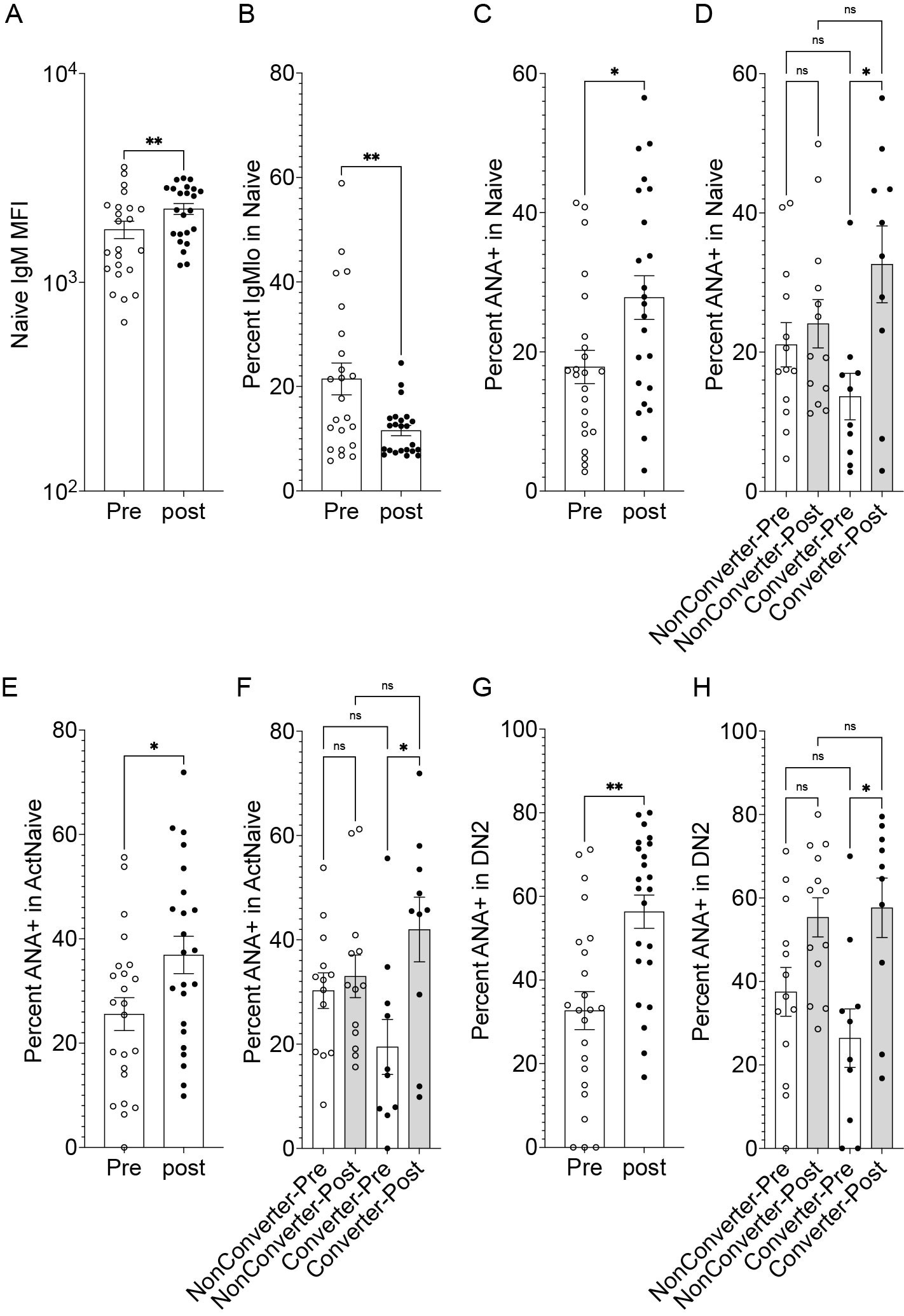Session Information
Session Type: Poster Session B
Session Time: 9:00AM-10:30AM
Background/Purpose: The development of new autoantibodies and secondary autoimmunity is a common and significant side effect of TNF inhibitors (TNFi) which are widely used to treat autoimmune diseases; however, the mechanism by which TNFi breach tolerance is to be determined. In both mice and humans, TNF deficiency disrupts the germinal center network (GC), which is a well-established site for generation of high affinity antibodies and autoantibodies. We recently reported that TNF deficiency in murine models breaches B cell tolerance via both extrafollicular and atypical GC pathways, and that defects in B cell regulatory signals such as CD22, may be responsible for breach of tolerance in the atypical GC. To determine the effect of TNFi on autoreactive B cell selection, we examined the distribution of B cell subsets and the frequency of autoreactive (ANA+) B cells in patients treated with TNFi.
Methods: PBMC were collected from patients with autoimmune diseases (Rheumatoid Arthritis, Psoriatic Arthritis, and Inflammatory Bowel Disease) before and after (≥ 6 months) TNFi treatment. We performed 20 color flow cytometry of PBMC from 23 patients, of whom 10 developed ANA or 4 fold increase in pre-existing ANA, and 13 had negative ANA before and after treatment. Nonbiased clustering FlowSOM Flowjo Plugins were used in conjunction with the traditional Flowjo gating to identify cell subsets. The percentage of ANA+ B cells was analyzed using fluorescent Hep-2 lysate as previously reported. Surface expression of CD22 and CD22 ligands were also examined. Wilcoxon, Kruskal-Wallis nonparametric ANOVA, and Dunn’s multiple comparisons test were used to compare groups.
Results: After TNFi treatment there was no significant change in the distribution of naïve, memory, double negative, activated naïve or transitional B cell subsets with the exception of a modest increase in transitional T2 B cells that was no longer significant after stratifying for ANA seroconversion. Surface IgM expression on naïve B cells after TNFi treatment was significantly increased, with a significantly lower percentage of IgMlo cells, a phenotype associated with functional anergy (Figure 1A-B). The percentage of ANA+ B cells was significantly increased after treatment in multiple B cell subsets including naïve (Figure 1C), IgMlo naïve, activated naïve (Figure E) and DN2 (CD27-IgD-CXCR5-CD11c+, Figure G) B cells; after stratifying for ANA seroconversion, these changes were significant only in the seroconversion group (Figure 1D, F, H). Surface CD22 expression on naïve B cells was significantly increased, whereas the CD22 high affinity ligand, MEM-55 which is acquired during differentiation from naïve to post-germinal center B cell fates was significantly reduced after treatment.
Conclusion: Our data suggest that TNF inhibitors induce a loss of B cell anergy in naïve B cells and this is associated with an increase in the proportion of autoreactive B cells within naïve, activated naïve and DN2 B cells. This may account for the production of low affinity non-pathogenic ANA in TNFi treated patients. Surface expression of the B cell signaling regulatory molecule CD22 and its ligands were also altered after TNFi treatment.
To cite this abstract in AMA style:
Quach T, Mackay M, Aranow C, Davidson A. The Distribution and Frequency of Autoreactive B Cells Are Altered in Autoimmune Patients After TNF Inhibitor Treatment [abstract]. Arthritis Rheumatol. 2022; 74 (suppl 9). https://acrabstracts.org/abstract/the-distribution-and-frequency-of-autoreactive-b-cells-are-altered-in-autoimmune-patients-after-tnf-inhibitor-treatment/. Accessed .« Back to ACR Convergence 2022
ACR Meeting Abstracts - https://acrabstracts.org/abstract/the-distribution-and-frequency-of-autoreactive-b-cells-are-altered-in-autoimmune-patients-after-tnf-inhibitor-treatment/

